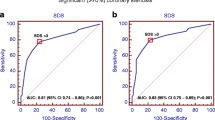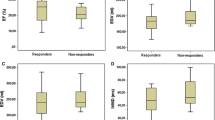Abstract
201Tl myocardial imaging was performed at rest and after dipyridamole (0.44 mg/kg) on 50 patients with known or suspected ischemic heart disease. The dipyridamole had no effect in 14 patients (group Dip. 0). In 17 patients (group Dip±) it significantly modified the contrast of the rest image (by increasing or decreasing a rest perfusion defect). In 19 patients (group Dip-Steal) the drug induced a paradoxical response interpreted as a coronary steal effect (an active region at rest becomes hypoactive after dipyridamole while an underperfused region at rest improves).
All patients underwent coronary arteriography and left monoplane ventriculography; results were interpreted in relation to these angiographic data. The mean percentage of stenoses (per patient) was about the same in the three groups but it was found that, despite these stenoses, the patients of the group Dip —Steal had a good left ventricular function (\({{\text{EF}}}\)=0.62±0.12). On the other hand, the ejection fraction was very poor in the two other groups (0.50±0.17 and 0.48±0.17). Moreover it was found that: (1) the frequency of high grade or even complete obstruction was notably less in group Dip-Steal (P<0.05); (2) the frequency of angiographically visible collaterals was higher in group Dip-Steal (P<0.05); (3) the left anterior descending artery was less diseased than the right coronary artery in group Dip-Steal (P<0.05).
These results have a real prognostic value for the assessment of the preserved cardiac performance in Dip-Steal patients despite severe stenoses, and are discussed in terms of compensatory collateral circulation and preservation of the coronary-flow reserve in the myocardium distal to a critical stenosis.
Similar content being viewed by others
References
Albro PC, Gould KL, Westcott RJ, Hamilton GW, Ritchie JL, Williams DL (1978) Non invasive assessment of coronary stenoses by myocardial imaging during pharmacologic vasodilatation. III Clinical trial. Am J Cardiol 42:751–760
Armitage P (1977) Statistical methods in medical research, 4th edn. Blackwell Scientific Publications Oxford-London-Edinburg-Melbourne
Bailey IK, Griffith LSC, Rouleau J, Strauss HW, Pitt B (1977) Thallium-201 myocardial perfusion imaging at rest and during exercise: comparative sensitivity to electrocardiography in coronary artery disease. Circulation 55:79–87
Baruthio J (1978) Contribution à l'évaluation de la performance cardiaque par un système d'acquisition et d'exploitation des données d'explorations fonctionnelles physiques. Thèse de Sciences, Strasbourg
Bassan M, Ganz W, Marcus HS, Swan JC (1974) The effect of intracoronary injection of contrast medium upon coronary blood flow. Circulation 51:442–445
Becker LC (1976) Effect of nitroglycerine and dipyridamole on regional left ventricular blood flow during coronary artery occlusion. J Clin Invest 58:1287–1296
Becker LC (1978) Conditions for vasodilator-induced coronary steal in experimental myocardial ischemia. Circulation 57:1103–1110
Bodenheimer MM, Banka VS, Fooshee C, Hermann GA, Helfant RH (1978) Relationship between regional myocardial perfusion and the presence, severity and reversibility of asynergy in patients with coronary heart disease. Circulation 58:789–795
Botvinik EH, Klausner SC, Shames D, Ratshin RA, Taradash MR, Parmley WW (1976) Prediction of abnormalities of left ventricular wall motion: analysis of patterns of relative myocardial blood flow vs ECG evidence of previous myocardial infarction. Clin Res 24:80A
Bourrassa MG, Mossard JM (1972) Coronarographie sélective percutanée. Technique et résultats basés sur une expérience de 3000 examens. J Radiol Electrol 53:583–591
Bross I (1952) Sequential medical plans. Biometrics 8:188–205
Brown KA, Boucher CA, Okada RD, Leppo J, Pohost GM, Strauss HW (1981) Serial right ventricular thallium imaging following dipyridamole and relationship to right coronary artery disease. Am J Cardiol 47:484 (Abst.)
Büll U, Niendorf HP, Strauer BE, Hast B (1976) Evaluation of myocardial function with 201Tl scintimetry in various diseases of the heart. Eur J Nucl Med 1:125–126
Büll U, Strauer BE, Bürger S, Witte J, Niendorf HP (1978) Effects of physical stress and pharmacologically induced coronary dilation on myocardial and non myocardial 201Tl-uptake. Eur J Nucl Med 3:19–27
Chamberlain D, Fenney L, Gishen P, Lutkin J, Timmis A, Burnwood R (1980) Cardiac scintigraphy: dipyridamole or exercise? Eur J Nucl Med 5:A23 (Abst.)
Charlier R (1971) Handbook of experimental pharmacology. XXXI. Antianginal drugs. Springer Verlag, Berlin Heidelberg New York, pp 181–188
Cole JS, Hartley C (1974) Instantaneous response of coronary blood flow to selective coronary injection of contrast media. A new stress test for significant stenosis. Circulation 49/50: suppl. III, III-5
Fam WM, Mc Gregor M (1964) Effect of coronary vasodilator drugs on retrograde flow in areas of chronic myocardial ischemia. Circ Res 15:355–365
Fletscher JW, Walter KE, Witztum KF, Daly JL, Herbig FK, Mueller HS, Donati RM (1978) Diagnosis of coronary artery disease with 201Tl. Computer analysis of myocardial perfusion images Radiology 128:423–427
Gould KL (1978a) Noninvasive assessment of coronary stenoses by myocardial perfusion imaging during pharmacologic coronary vasodilatation. I. Physiologic basis and experimental validation. Am J Cardiol 41:267–278
Gould KL (1978b) Assessment of coronary stenoses with myocardial perfusion imaging during pharmacologic coronary vasodilation. IV. Limits of detection of stenosis with idealized experimental cross-sectional myocardial imaging. Am J Cardiol 42:761–768
Gould KL, Lipscomb K, Hamilton GW (1974a) Physiologic basis for assessing critical coronary stenosis. Instantaneous flow response and regional distribution during coronary hyperemia as measures of coronary flow reserve. Am J Cardiol 33:87–94
Gould KL, Hamilton GW, Lipscomb K, Ritchie JL, Kennedy JW (1974b) Method for assessing stress-induced regional malperfusion during coronary arteriography. Experimental validation and clinical application. Am J Cardiol 34:557–564
Gould KL, Westcott RJ, Albro PC, Hamilton GW (1978) Noninvasive assessment of coronary stenoses by myocardial imaging during pharmacologic coronary vasodilatation. II. Clinical methodology and feasibility. Am J Cardiol 41:279–287
Hamilton GW, Trobaugh GB, Ritchie JL, Williams DL, Weaver WD, Gould KL (1977) Myocardial imaging with intravenously injected thallium-201 in patients with suspected coronary artery disease. Analysis of technique and correlation with electrocardiographic, coronary anatomic and ventriculographic findings. Am J Cardiol 39:347–354
Holman BL, Cohn PF, Adams DF (1976) Regional myocardial blood flow during hyperemia induced by contrast agent in patients with coronary artery disease. Am J Cardiol 38:416–421
Hör G, Sebening H, Sauer E, Dressler J, Lutilsky L, Wagner-Manslau C, Bofilias I, Wolf I, Pabst HW (1979) 201Tl-redistribution analysis in early and delayed myocardial scintigrams of patients with coronary heart disease. Eur J Nucl Med 4:343–350
Horwitz LD, Currey GC, Parkey RW (1974) Differentiation of physiologically significant coronary artery lesions by coronary blood flow measurements during isoproterenol infusion. Circulation 49:55–62
Josephson MA, Brown BG, Hecht HS, Hopkins J, Pierce CD, Petersen RB (1980) Detection and localization of ≧40% coronary stenosis in patients: comparison of exercise and dipyridamole thallium-201 imaging. Am J Cardiol 45:399 (Abst.)
Leppo J, Boucher CA, Okada RD, Strauss HW, Pohost GM (1981) Utility of serial thallium imaging following dipyridamole. Am J Cardiol 47:483 (Abst.)
Lösse B, Kuhn H, Rafflenbeul D, Kronert H, Hort W, Feinendegen LE, Loogen F (1980) Scintigraphie myocardique au thallium-201 chez les patients à coronaires et ventriculographie normales. Comparaison avec des constatations hémodynamiques, métaboliques et morphologiques. Ann Cardiol Angéiol 29:265–273
Lutkin J, Timmis A, Fenney L, Gishen P, Burnwood R, Chamberlain D (1980) Dipyridamole compared with exercise for thallium scanning. Br Heart J 43:11
Machecourt J, Denis B, Wolf JE, Comet M, Pellet J, Martin-Noel P (1981) Sensibilité et spécificité respective de la scintigraphie myocardique réalisée après injection de 201Tl au cours de l'effort, après injection de dipyridamole et au repos. Arch Mal Coeur 74:147–156
Massie BM, Botvinik EH, Brundage BH, Greenberg B, Shames D, Gelberg H (1978) Relationship of regional myocardial perfusion to segmental wall motion. A physiologic basis for understanding the presence and reversibility of asynergy. Circulation 58:1154–1163
Mc Killop JH, Bessent RG, Murray RG, Turner JG, Tweddel A, Greig WR (1978) A quantitative approach to the analysis of the normal thallium-201 myocardial image. Eur J Nucl Med 3:223–225
Mc Killop JH, Murray GM, Bessent RG, Turner JG, Greig WR, Lorimer AR (1979) The significance of the abnormal rest thallium-201 myocardial image in coronary artery disease. Eur J Nucl Med 4:83–86
Mc Laughlin PR, Martin RP, Doherty P, Daspit S, Goris M, Haskell W, Lewis S, Kriss JP, Harrisson DC (1977) Reproducibility of thallium-201 myocardial imaging. Circulation 55:497–503
Pohost GM, Zir LM, Moore RH, Mc Kusick KA, Guiney TE, Beller GA (1977) Differentiation of transiently ischemic from infarcted myocardium by serial imaging after a single dose of thallium-201. Circulation 55:294–302
Ramo BW, Peter RH, Ratliff N, Kong Y, Mc Intosh HD, Morris JJ Jr (1970) The natural history of right coronary arterial occlusion in the pig. Comparison with left anterior descending arterial occlusion. Am J Cardiol 26:156–161
Ritchie JL, Hamilton GW, Gould KL, Allen D, Kennedy JW, Hammermeister KE (1975) Myocardial imaging with indium-113m and technetium 99m-macro-aggregated albumin. New procedure for identification of stress-induced regional ischemia. Am J Cardiol 35:380–389
Ritchie JL, Trobaugh GB, Hamilton GW, Gould KL, Narahara KA, Murray JA, Williams DL (1977) Myocardial imaging with thallium-201 at rest and during exercise. Circulation 56:66–71
Schmoliner R, Dudczak R, Kronik G, Kletter K, Hutterer B, Mösslacher H, Frischauf H (1980) Die Aussagekraft der Thallium-Szintigraphie nach Dipyridamol in der Diagnostik der Koronaren Herzkrankheit. Z Kardiol 69:179
Schmoliner R, Dudczak R, Kronik G, Hutterer B, Kletter K, Mösslacher H, Frischauf H (1981) Thallium-201 myocardial imaging after high dose Dipyridamole. Z Kardiol 70:111–115
Schwartz JS, Ponto R, Carlyle P, Forstrom L, Cohn JN (1978) Early redistribution of thallium-201 after temporary ischemia. Circulation 57:332–335
Slany J, Mösslacher H, Imhof H, Bodner P (1974) Untersuchungen zum coronary-steal-Phänomen bei koronarer Herzkrankheit. Verh Dtsch Ges Kreislaufforsch. 40:435–439
Souza(D') VJ, Schwartz JS, Amplatz K (1978) Correlation between intracoronary 201Tl myocardial scanning, coronary angiography and left ventriculography. Radiology 127:433–436
Strauss HW, Pitt B (1977) Noninvasive detection of subcritical coronary arterial narrowings with a coronary vasodilator and myocardial perfusion imaging. Am J Cardiol 39:403–406
Tauchert M, Behrenbeck DW, Hötzel J, Hilger HH (1976) Ein neuer pharmakologischer Test zur Diagnose der Koronarinsuffizienz. Dtsch Med Wochenschr 101:35–37
Wainwright RJ, Maisey MN, Edwards AC, Sowton E (1980) Functional significance of coronary collateral circulation during dynamic exercise evaluated by thallium-201 myocardial scintigraphy. Br Heart J 43:47–55
Walker PR, Wilde RPH, Watt I, Rhis-Davies E, Rees JR (1980) Comparison of 201Tl myocardial imaging after coronary vasodilatation with dipyridamole and after maximal treadmill exercise. Br Heart J 43:111
Yamazaki H, Aya S, Horikawa M, Matsumura N (1975) Effects of radioopaque material on coronary vascular reserve. Jap Heart J 16:57–64
Zaret BL, Strauss HW, Martin ND, Wells HP, Flamm MD (1973) Non invasive regional myocardial perfusion with radioactive potassium: study of patients at rest, exercise and during angina pectoris. N Engl J Med 288:809–812
Zir LM, Pohost GM, Gold HK, Leinbach RC, Dinsmore RE (1976) The significance of reversal of left ventricular asynergy by post extrasystolic potentiation: a comparison of left ventriculography and 201Tl myocardial scans. Circulation 54:Suppl. II, II-5
Author information
Authors and Affiliations
Rights and permissions
About this article
Cite this article
Demangeat, J.L., Constantinesco, A., Mossard, J.M. et al. Evaluation of myocardial perfusion and left ventricular function by 201Tl scintigraphy after dipyridamole. Eur J Nucl Med 6, 491–503 (1981). https://doi.org/10.1007/BF00255881
Received:
Issue Date:
DOI: https://doi.org/10.1007/BF00255881




